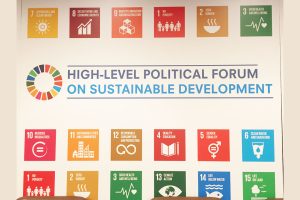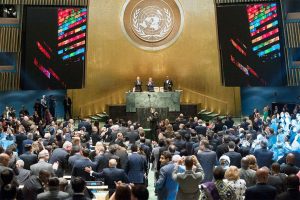10 July 2019: A side event convened by the World Health Organization (WHO) on the sidelines of the 2019 High-level Political Forum on Sustainable Development (HLPF) raised awareness of the Global Action Plan for Healthy Lives and Well-being for All (GAP) as an instrument to support countries to strengthen their healthcare systems and accelerate the achievement of health-related targets under the 2030 Agenda for Sustainable Development.
The GAP will be launched during this year’s UN General Assembly, helping to create a strong link to the High-level meeting on Universal Health Coverage (UHC) and the SDG Summit, also taking place in September 2019.
The side event, ‘Global Action Plan for Healthy Lives and Well-being for All: A Commitment to Accelerating Together,’ provided an opportunity for Member States and other stakeholders to learn more about the GAP, while providing feedback and showcasing how acceleration towards the health-related SDG targets can be achieved through coordinated and multisectoral actions. Introducing the GAP initiative, Stewart Simonson, Assistant Director-General, WHO’s office at the UN in New York, US, noted that at current rates of implementation, many countries will not achieve some crucial targets under SDG 3 (good health and well-being), including on HIV, maternal mortality rates, and tuberculosis.
The discussions identified a number of areas for action, including: strengthening sustainable financing and primary health care; improving women’s quality of life through access to sexual reproductive services and equitable gender norms; and addressing environmental determinants such as air pollution, which is linked to the premature deaths of seven million people each year.
During a panel discussion on interlinkages with other global goals, participants highlighted the need for empowering communities to lead SDG implementation, such as in the case of HIV response. It was noted that the GAP provides an opportunity for international agencies to achieve greater synergies in their support of local action and ensure a coherent approach to addressing cross-cutting issues such as gender equality (SDG 5) and climate action (SDG 13), as well as scaling up health investments.
The debate highlighted that the GAP is not a Member State-negotiated document, and called for greater engagement of multiple stakeholders, in particular the private sector. Interested countries and stakeholders were invited to develop and implement their own country-specific acceleration approaches in time for the first planned stocktaking milestone in 2023.
The GAP is a WHO-led initiative to unite organizations and key stakeholders to respond to health challenge in a holistic manner. Organized around three strategic approaches, “Align, Accelerate and Account,” the GAP seeks to reduce inefficiencies through, for example, harmonizing financing and procurement and strengthening the provision of essential global public goods for health. The GAP initiative was developed in response to a request from Chancellor Angela Merkel of Germany, President Nana Addo Dankwa Akufo-Addo of Ghana and Prime Minister Erna Solberg of Norway, with support from UN Secretary-General António Guterres.
IISD Reporting Services is providing coverage of selected side events during the 2019 HLPF. [IISD RS Coverage of the Side Event] [GAP Website]



